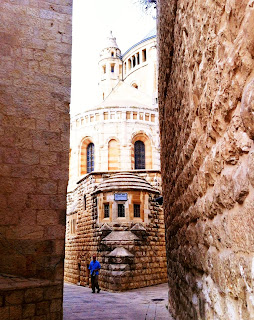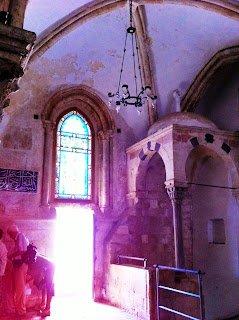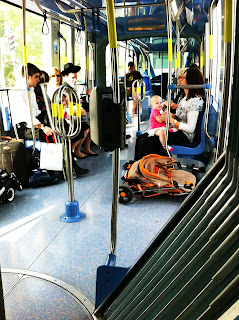We would've also added Dome of the Rock to the title, but we decided not to stay in the long Disneyland-esque line, waiting in the scorching Middle Eastern sun for over an hour to see...more mosques. The mosque is built on top of the foundation of the Second Temple so it happens to be the holiest place for Jews and the third holiest for Muslims. However, non-Muslims can only go into the Temple Mount space, and cannot enter the Dome of the Rock or the Al-aqsa mosques anyway, plus we've literally seen dozens of mosques for the past 6 weeks, so we let this one go. We took some photos from the exterior.
After walking through Jaffa Gate of the Old City, we walked past David's Tower and ruins of King Herod's palace remains, kept going through the Armenian Quarter, and found our way to Zion Gate, which led us out of the Old City walls onto Mount Zion.
 |
| Jaffa Gate on western wall of Old City |
 |
| David's Tower and remains of Herod's palace |
 |
| Walking through Armenian Quarter of Old City. Clock tower on Mount Zion in horizon. |
Mount Zion and the gate is an interesting story. After the creation of the State of Israel in 1948, the Old City was occupied by Jordan and Jews could not visit their holiest sites for almost 20 years. The closest they could get to Temple Mount to pray was on the rooftop of David's Tomb on Mount Zion, which was under Israeli control. In 1967, Zion Gate was riddled with bullets during the fierce Six-Day War where Israel was able to capture the Old City from Jordan.
Another interesting story goes that when the Turkish sultan, Suleiman the Magnificent, had the wall restored in the 1500s, the builders accidentally forgot to include Mount Zion within the ciy walls. The Sultan was so irate, he sentenced the two engineers to death.
Mount Zion has several known landmarks and is outside of the Old City walls. After walking past the Dormition Abbey and Franciscan Convent, above David's Tomb is the room where Jesus took his Last Supper with his disciples. Above this room is a nice rooftop view of Jerusalem. Schindler, the guy who saved 1,200 Jews (e.g. movie: Schindler's List) is buried in a cemetery on Mount Zion.
 |
| On Mount Zion. Dormition Abbey and Franciscan Convent. |
 |
| Upstairs above David's Tomb on way to room where Jesus had his Last Supper. |
 |
| Upstairs room where Jesus had his Last Supper with his disciples |
 |
| Cemetery on Mount Zion. |
 |
| Statue of King David |
 |
| Tomb of King David. Synagogue built around it with separation wall for men and women. |
The second most holy place for Jews is the Western Wall (or Wailing Wall) of the Temple Mount. Security was tight, going into this area with plenty of police and metal detectors. The wall itself is a synagogue. Men and women have separate entrances and must wear appropriate clothing and a yarmulke for the men. We took a moment of silence and reflection by the wall amongst the many praying Jews. It was a very spiritual moment.
Yad Vashem means "a memorial and a name". No trip to Israel is complete without making an homage to the world's largest and most comprehensive memorial to the holocaust.
The stark, concrete museum is built atop Mount Herzl and is very easy to access by tram. Photos were strictly forbidden so we only have a few exterior shots, but you can imagine what was inside, especially if you've had the privilege of visiting the well-curated Holocaust Museum in Washington DC.
Yad Vashem provided a comprehensive history of the roots of anti-semitism (still don't get it, but I guess you can't explain crazy and evil); the gradual stripping of civil rights and independence amongst the Jews; the increased persecution and suffering which eventually led to the "Final Solution"; as well as a place to honor non-Jews who helped them survive.
The sheer volume of donated artifacts telling their personal stories of both victims and survivors was truly amazing. At the end is the Hall of Names where every known Jewish victim's biography is catalogued and stored on the shelves lining this rotunda. The center of the rotunda is a deep hole that looks strikingly similar to the many mass graves dug where the Jews were buried. It looked so real and eerie that I completely lost it.
The sheer volume of donated artifacts telling their personal stories of both victims and survivors was truly amazing. At the end is the Hall of Names where every known Jewish victim's biography is catalogued and stored on the shelves lining this rotunda. The center of the rotunda is a deep hole that looks strikingly similar to the many mass graves dug where the Jews were buried. It looked so real and eerie that I completely lost it.
It took us nearly 3 hours to go through the museum, and that was just skimming through much of the information, so we highly recommend a visit to Yad Vashem but make sure to allocate plenty of time.
NEW WEST JERUSALEM
To lift our spirits, we decided to explore the city center of New Jerusalem. Around Jaffa Street, King David Street, and the pedestrian Ben-Yehuda Street are plenty of restaurants, bars, and shopping.
Unfortunately, we didn't realize everyone was getting ready for another holiday and businesses were either already closed or shutting down around 3:30 pm to get ready for the Sukkot Holiday, which starts at sundown. In fact, the buses quit running at 1 pm so we had to walk all the way back to our apartment.
 |
| Inside the tram. |
 |
| Lively scene on Ben-Yehuda Street. Live DJ spinning dance music while kids are dancing but it's silent because the music can only be heard through headphones! |
 |
| Mike finally found his place in Jerusalem. Enjoying a Goldstar beer. |
SUKKOT
The Sukkot (Feast of Tabernacles) holiday runs for 7 days, although only the first and last days are observed like the sabbath. During Sukkot, a sukkah, or temporary shelter made of palm leaves or other natural material is built to represent the life while wandering in the wilderness for 40 years. Everyone feasts and sometimes sleeps in these sukkahs for 7 days. We saw lots of sukkah being built outside of the restaurants during our walk.






















